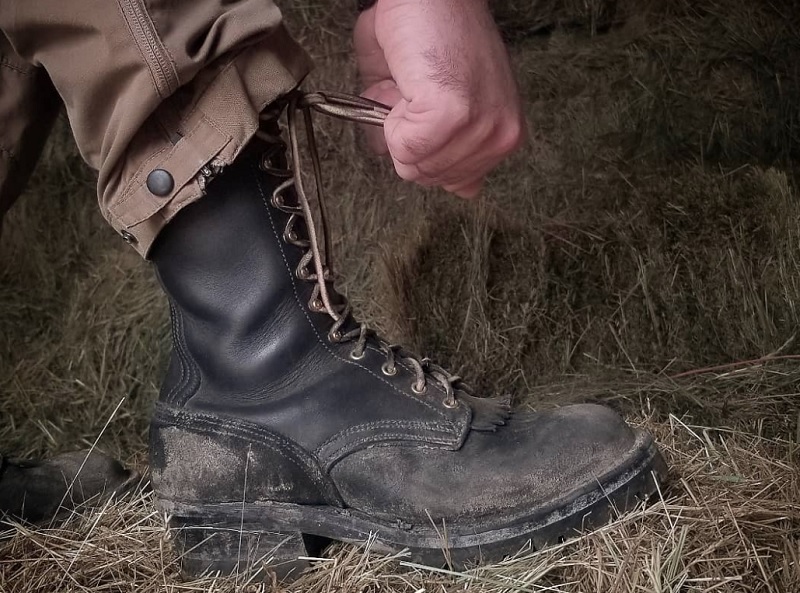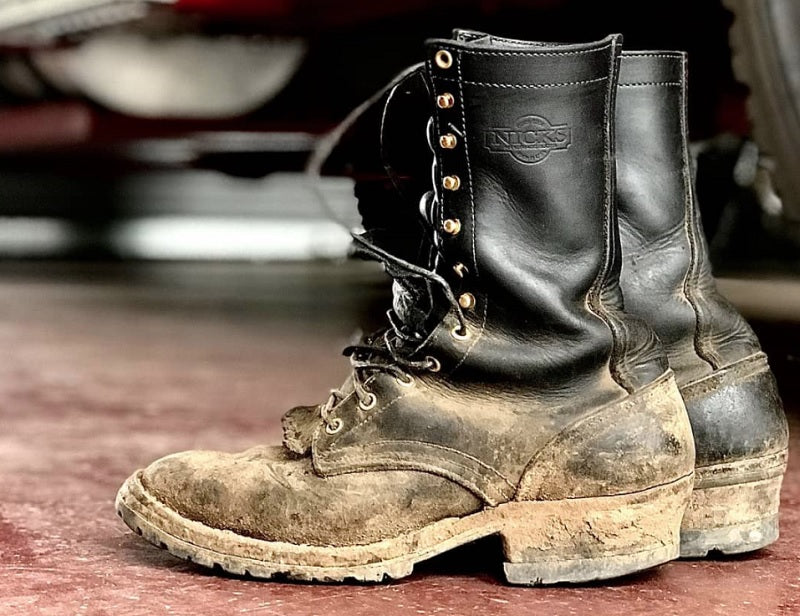Work boots should fit just tightly enough to support your foot, but loosely enough to let your foot flex and move as it's supposed to. They should neither be too tight or too loose.
When you get your first pair of quality footwear that's actually the correct size - whether it's a pair of sneakers, dress shoes or work boots - you understand what shoes or boots are supposed to feel like.
But what does that actually mean?
Your Heel Should Be Supported Without Chafing

When your heel sets into the heel cup of a pair of boots, what you should be feeling is your heel being cupped, like it's being supported.
The heel should feel snug, but shouldn't feel like it's being chafed. You should be able to get your heel into the boot with typical socks that you'd wear, including a pair of thicker wool socks during the winter.
When you're walking, there shouldn't be any lift; the heel of the boot has to move with you.
The heel block - or heel of the wedge if you're wearing wedge boots - should feel solid under the heel. When you walk, it shouldn't feel like it's hitting the heel, but rather taking the hit for the heel.
It's okay if the heel is a little tight at first. This is one of the areas that has to be broken in, so a bit of chafing is going to happen for those first few weeks...but not after break-in.
You Should Have The Right Amount Of Arch Support

The other critical area of work boot fitment is the arch. Some people need more arch support, some people need less, but everyone needs some with a pair of boots.
You should feel additional material in the entire arch, neither too short nor too long; the supporting structure in the insole and footbed shouldn't be under the ball of the foot.
The arch is the spring of the foot. When you're wearing more substantial boots or shoes (beyond barefoot shoes or slippers) the additional material gives the arch support so that the boot moves with the foot and doesn't interfere with motion.
You'll know the arch fits correctly if you notice a lot less fatigue in your feet and a lot less soreness. Aching feet and heels are usually caused by a lack of arch support, though having less than ideal support in the heel matters too.
The Toe Box Should Allow Enough Room For The Forefoot
The toe box, along with the arch, is one of the most-overlooked areas when it comes to fitment.
Too tight, and you'll get pinched toes and bunions. Too loose, and you'll develop hot spots...and going downhill will be a lot less pleasant.
In the early 20th century, an army doctor (Dr. Edward Munson) started looking at xrays of various people who had foot injuries in the service. What he found was that most of them were caused by boots that didn't fit the feet of the soldiers.
He developed a boot last that had a snug heel but a wide toe box, allowing the forefoot to flex as it's supposed to and the foot to work as it would naturally if a person weren't wearing shoes. That last - the Munson or Garrison last - was used for US military footwear from WWI until the jungle boot was adopted.
And it works, too; Munson last boots (and similar designs) are known for being very comfortable to walk in for long periods so long as they're made properly.
You should feel a little bit of room on both sides of your feet. Not so much that your feet are swimming, but enough to wiggle your toes.
When you walk, the forefoot flexes and expands, and then contracts after your foot pushes off. The toe box has to give you enough room for this to happen. If your feet are actually a wide size, you need to have boots that are too.
Guarantee Fitment By Getting Work Boots Made-To-Order
Some people have great luck getting work boots off the shelf from stores that fit. A lot of people don't.
The best way to get work boots that fit as they're supposed to? Getting a pair that's made-to-order.
Custom work boots will get you the fitment that you need for best results from a pair of work boots. You start with a fitting, by getting your feet measured at key points. The bootmaker then selects a last that fits these specifications, and the boot is made to measure.
The custom fitment gives you the fit you need for a pair of work boots, including the fit at the heel, the toe box and in the arch. Your feet will be more comfortable, you'll experience a lot less foot fatigue, and you'll decrease the chances of lower leg injuries due to poorly-fit footwear.
Why not invest in your own health and well-being?





































